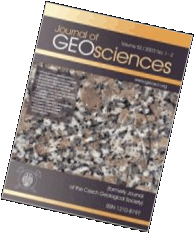Original Paper
Is the partitioning of boron between tourmaline and muscovite dependent on the crystallization environment?
Journal of the Czech Geological Society, volume 45 (2000), issue 1-2, 13 - 20
According to classical mineralogical wisdom, tourmaline contains the constant amount of 3.0 boron atoms per formula unit (p. f. u.) located in trigonal (BO3)-units of the structure, and muscovite is a boron-free mineral, so that a distribution coefficient DB (=concentration of B in tourmaline / concentration of B in muscovite) is infinity. Recent analytical and experimental results show, however, that both assumptions do not always hold. Reviews are presented on natural and synthetic Al-rich tourmalines (olenites) containing up to 2.27 B p. f. u. of excess boron located in the tetrahedral ring site replacing silicon, and on natural and synthetic micas in the system muscovite - boromuscovite (KAl2[BSi3O10](OH)2). Like for excess-boron olenite, boromuscovite synthesis is favored by high pressures and low temperatures. The muscovite with the highest B-content found thus far coexists with excess-boron olenite (resulting in a DB-value of 5.62) in a unique pegmatite that may have formed at, or been subjected to, relatively high pressures and low temperatures. However, Al-rich, very Mg, Fe-poor chemical environments alone may also favor tetrahedral boron in both minerals, because - if Mg, Fe2+ were present - these two elements would preferentially fractionate into tourmalines of the dravite-schorl series which thus far have always been found to contain only stoichiometric trigonal boron. At the same time, boron seems to fractionate preferably into these Mg, Fe-tourmalines rather than into muscovite, at least under normal crustal pressure conditions. More experimentation is warranted to determine variations of DB as a function of PTX-conditions, with the possibility that this property be used to evaluate the conditions of formation of tourmaline - muscovite pairs.
Webdesign inspired by aTeo. Hosted at the server of the Institute of Petrology and Structural Geology, Charles University, Prague.
ISSN: 1803-1943 (online), 1802-6222 (print)
email: jgeosci(at)jgeosci.org


IF (WoS, 2024): 1.3
5 YEAR IF (WoS, 2024): 1.4
Policy: Open Access
ISSN: 1802-6222
E-ISSN: 1803-1943
 Export to Mendeley
Export to Mendeley